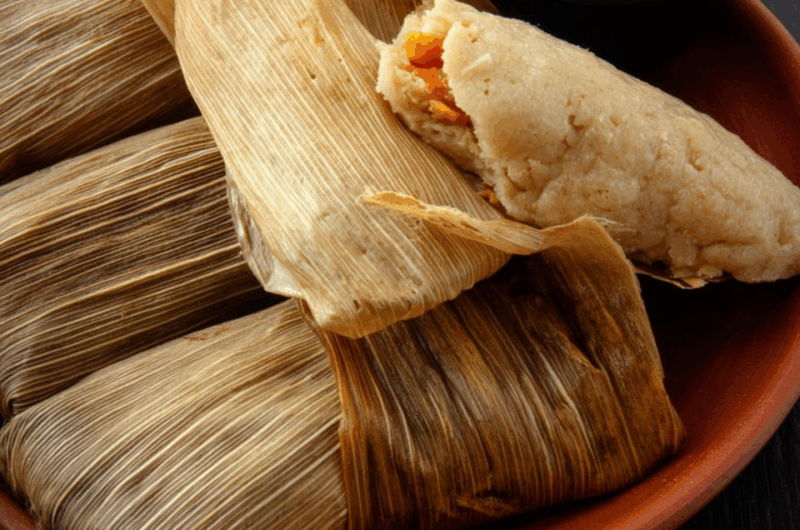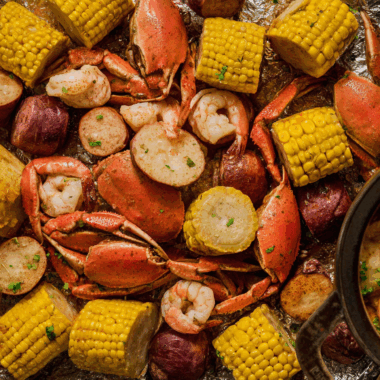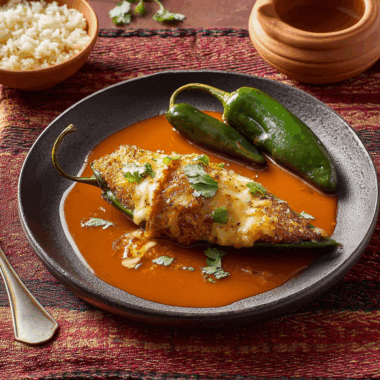Tamales Oaxaqueños are a culinary treasure from southern Mexico, celebrated for their unique preparation in banana leaves. Unlike corn husk tamales, these are softer, more aromatic, and infused with the subtle smoky flavor of the leaves during steaming. Inside, tender pork is simmered in a rich chile sauce that balances heat with earthiness, creating a deeply satisfying bite.
They are often served during holidays and family gatherings, symbolizing tradition and togetherness. Each tamal is a small gift wrapped with care, making the process as beautiful as the flavor itself. Whether enjoyed with salsa, crema, or on their own, Oaxacan tamales are a true masterpiece of Mexican cuisine.
Full Recipe:
-
3 dried ancho chiles
-
3 dried guajillo chiles
-
2 dried pasilla chiles
-
2 cloves garlic
-
1 teaspoon cumin seeds
-
1 teaspoon dried oregano
-
1 cup chicken broth
-
2 pounds pork shoulder, cut into chunks
-
2 teaspoons salt
-
1 cup lard (or vegetable shortening)
-
4 cups masa harina (corn flour for tamales)
-
2 cups chicken broth (additional for masa)
-
20 fresh or thawed banana leaves, cleaned and cut into 12-inch squares
-
Kitchen twine for tying
Directions:
-
Soak ancho, guajillo, and pasilla chiles in hot water until soft. Remove seeds and stems.
-
Blend chiles with garlic, cumin seeds, oregano, and 1 cup chicken broth until smooth.
-
In a large pot, simmer pork shoulder in the chile sauce with 2 teaspoons salt until tender (about 1 ½–2 hours). Shred the meat and keep the sauce.
-
In a mixing bowl, beat lard until fluffy. Add masa harina and slowly mix in 2 cups chicken broth until dough is soft but not sticky. Season with salt.
-
To assemble: place a banana leaf square on a flat surface. Spread ¼ cup masa dough into a rectangle in the center. Add a spoonful of shredded pork with chile sauce. Fold the leaf around the filling like a package and tie with kitchen twine.
-
Arrange tamales upright in a large steamer pot. Cover with leftover banana leaves and steam over medium heat for 1 ½ hours, or until masa is firm and cooked through.
Prep Time: 45 minutes | Cooking Time: 2 hours 30 minutes | Total Time: 3 hours 15 minutes
Kcal: ~340 kcal | Servings: 12 tamales
The Cultural Significance of Tamales in Mexico
Tamales are one of the most iconic and enduring foods in Mexican cuisine. Their origins trace back thousands of years to pre-Hispanic civilizations such as the Aztecs, Maya, and Olmecs. These ancient cultures relied heavily on corn as a sacred and central crop, and tamales became a portable, nourishing meal for warriors, hunters, and travelers. They were often prepared for religious ceremonies and festivals, making them not only a staple food but also a symbol of community, ritual, and celebration.
In contemporary Mexico, tamales are still deeply tied to family traditions and festivities. They appear during holidays such as Día de los Muertos, Christmas, and Día de la Candelaria. Families often gather to make tamales together in what is known as a tamalada, a social event that blends cooking with storytelling, laughter, and bonding across generations.
What Makes Oaxacan Tamales Unique
While tamales exist in countless regional variations across Latin America, Oaxacan tamales, or tamales Oaxaqueños, stand out for their distinct preparation. Instead of being wrapped in corn husks like most Mexican tamales, these are enveloped in banana leaves. The leaves impart a unique earthy aroma and a subtle smoky flavor as the tamales steam, giving them a softer and moister texture compared to their husk-wrapped counterparts.
The filling is another defining feature. Pork is the traditional protein of choice, slow-cooked in a rich sauce made from a blend of dried chiles such as ancho, guajillo, and pasilla. This sauce is smoky, spicy, and deeply layered with flavors that reflect Oaxacan cuisine’s love for complexity. The combination of masa, chile sauce, and tender meat makes each tamal a small package of comforting and aromatic delight.
The Role of Banana Leaves in Flavor and Presentation
Banana leaves are not just functional wrappers—they are an essential component of the dish. When heated, the leaves release natural oils and aromas that infuse the masa with a distinct character. This results in tamales that are more fragrant and moist compared to corn husk versions. Beyond their culinary contribution, banana leaves also enhance the presentation. Their vibrant green wrapping gives each tamal a rustic yet elegant appearance, making the meal feel special from the very first glance.
Oaxacan Tamales and Festivities
In Oaxaca, tamales are more than a meal—they are a celebration. They are most commonly prepared during the Christmas season, on All Saints’ Day, and during family milestones such as weddings or baptisms. The process of making them is labor-intensive, requiring teamwork, which is why it’s rarely done alone.
For many families, preparing tamales becomes a full-day event where relatives gather to clean banana leaves, prepare masa, cook fillings, and assemble dozens of tamales. Each participant contributes, from the youngest members helping to fold banana leaves to the elders ensuring the flavors are balanced and authentic. When finally served, the tamales are not just food but a collective memory of togetherness and shared effort.
Regional Variations of Oaxacan Tamales
Although pork with red chile sauce is the most iconic version, Oaxaca offers several variations of tamales that reflect the region’s culinary diversity. Some are filled with chicken instead of pork, often paired with mole negro or mole amarillo. Vegetarian versions might include mushrooms, squash blossoms, or beans combined with spicy sauces.
Another popular twist is the tamales de frijol, filled with black beans and sometimes flavored with avocado leaves, which add an anise-like aroma. Sweet tamales also exist, filled with raisins, pineapple, or even chocolate, wrapped in banana leaves for a comforting dessert. Each variation demonstrates the creativity of Oaxacan cooks while preserving the traditional essence of the dish.
How Tamales Bring Families Together
The making and eating of tamales embody the spirit of Mexican family life. A tamalada is more than cooking—it is an event that fosters unity and joy. Generations gather around tables, laughing, singing, and sometimes even debating over the right consistency of masa or the spiciness of the chile sauce. It is in these moments that culinary traditions are passed down, ensuring younger generations understand not just the techniques but also the cultural weight of the dish.
When finally enjoyed, tamales are often served with hot atole or champurrado, thickened drinks made from corn and chocolate. This pairing transforms the meal into an even warmer, heartier experience. The act of unwrapping the banana leaves to reveal the steaming tamal inside mirrors the joy of opening a gift, adding an element of excitement and gratitude to each serving.
Serving Suggestions for Oaxacan Tamales
Oaxacan tamales are versatile and can be served in many settings. Traditionally, they are enjoyed as a main dish, accompanied by simple sides such as Mexican rice, beans, or a fresh salsa. For breakfast, they can be paired with a cup of coffee or hot chocolate. During holidays, they often share the table with festive spreads of pozole, mole, or roasted meats.
For a modern twist, tamales can be plated individually with a drizzle of crema, a sprinkle of fresh cheese, and a side of guacamole. Their banana leaf wrapping also makes them perfect for serving at outdoor gatherings or picnics, as they travel well and retain their heat for longer periods.
The Global Appreciation of Oaxacan Tamales
As Mexican cuisine continues to gain recognition worldwide, Oaxacan tamales have found a place on international menus. Food enthusiasts admire them not only for their flavors but also for their rich cultural story. In gourmet restaurants, chefs present them with artistic plating, while in street food markets abroad, vendors recreate the homey authenticity of traditional tamaladas. This global appreciation helps preserve the dish while inviting more people to discover Oaxaca’s culinary heritage.
Why Oaxacan Tamales Are Worth the Effort
Preparing Oaxacan tamales can be time-consuming, but the result is more than worth it. Each tamal represents patience, tradition, and love woven into layers of masa, sauce, and filling. The distinct taste imparted by banana leaves cannot be replicated by shortcuts, making them a truly special dish reserved for occasions that matter. Whether you are making them at home for your family or enjoying them at a local Mexican eatery, Oaxacan tamales stand as a reminder that food is not only nourishment but also a powerful expression of culture and identity.
Conclusion
Oaxacan tamales are far more than a regional specialty—they are a piece of living history. From their pre-Hispanic roots to their role in modern-day festivities, they embody tradition, community, and the artistry of Mexican cuisine. The banana leaves give them a unique fragrance, while the chile-simmered pork filling adds depth and richness to every bite.
When families come together to prepare these tamales, they are preserving a cultural ritual that connects generations. And when shared at the table, each tamal becomes an offering of love, heritage, and flavor. For anyone seeking to understand the essence of Mexican cooking, Oaxacan tamales are an unforgettable experience—a dish where history, community, and taste converge beautifully.








